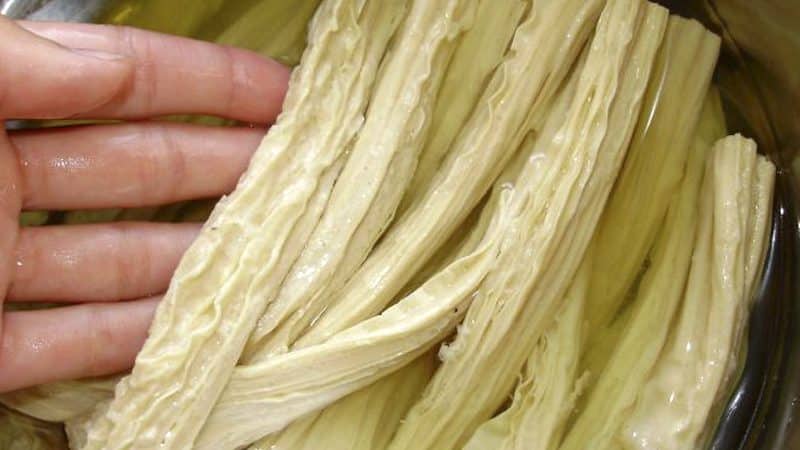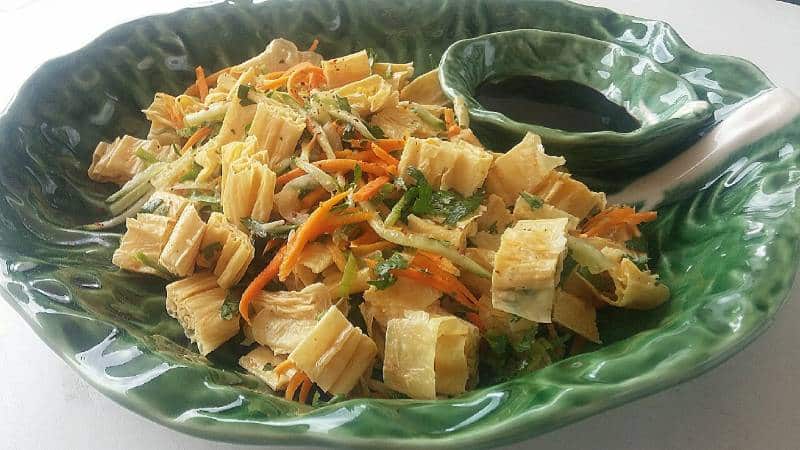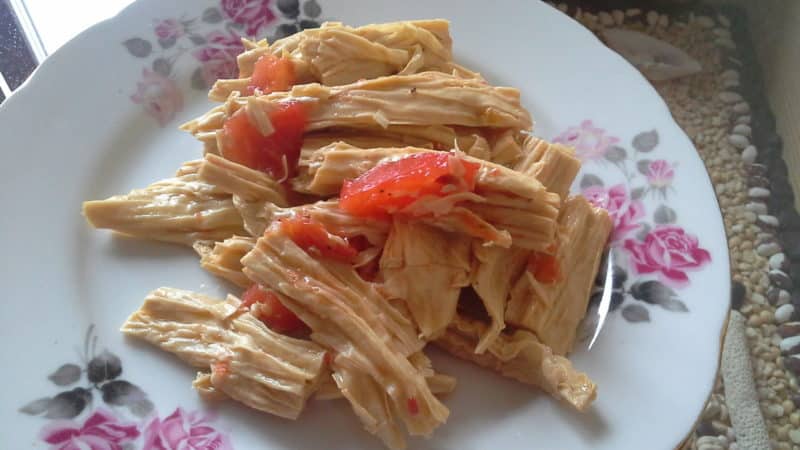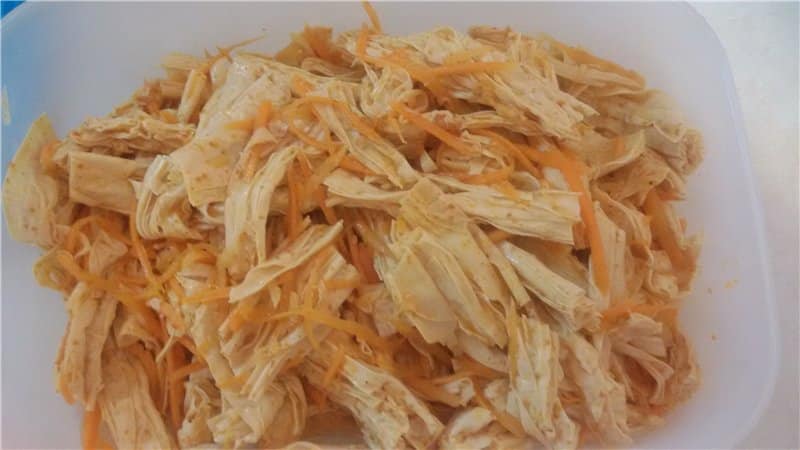What is soy asparagus, how is it useful and how to use it correctly
Soy asparagus and dishes made from it are a favorite product of admirers of Japanese and Chinese culinary cultures. This nutritious, high-protein semi-finished product satisfies perfectly, allowing you to not feel hungry for a long time.
We will tell you what soy asparagus is made from, what benefits and harm it brings to our body, and what dishes it is added to.
Product Description
Soy asparagus is a semi-finished product that is used for preparing salads, side dishes, and soups. The name itself is a ploy by marketers aimed at popularizing an unknown product in Russia. In China it is called fuzhu, in Korea - jujube, in Japan - douli.
In the US, the product is known as “tofu skin” (literally “tofu skin”), which is more accurate. The product has nothing to do with green asparagus (asparagus).
What and how is it obtained from?
Soybeans are used to prepare fuju. They are soaked in water in advance, then ground into a homogeneous mass and boiled into soy milk. During the boiling process, a film forms on top, which is removed and dried.

Chemical composition
Fuzhu includes:
- vitamins (A, C, H, PP, group B);
- macroelements (magnesium, calcium, sodium, sulfur, chlorine);
- trace elements (copper, iron, manganese, fluorine);
- nonessential and essential amino acids (arginine, lysine, tryptophan, isoleucine);
- fatty acids (omega-3, 6, 9).
Calorie content and BZHU
Nutritional value of dry product per 100 g:
- proteins - 45 g;
- fats - 20 g;
- carbohydrates - 20 g;
- calorie content - 440 kcal.
Nutritional value of soaked product per 100 g:
- proteins - 15.8 g;
- fats - 7.65 g;
- carbohydrates - 1 g;
- calorie content - 118.29 kcal.
Benefits and harms

Soy asparagus has a number of beneficial properties:
- The product is called the source of eternal youth. It contains entirely digestible protein of plant origin, similar in structure to animal protein. Therefore, nutritionists recommend that vegetarians include fuju in their diet.
- Asparagus is one of the foods that improve the functioning of the cardiovascular system.
- Antioxidants in its composition reduce the risk of developing cancer.
- Soy protein reduces “bad” cholesterol and stabilizes blood sugar.
- Natural estrogens normalize hormonal levels in women.
- Amino acids slow down the aging process and help maintain skin tone.
The negative effect of the product on the body can be traced in case of excessive consumption. There is a metabolic disorder, a deterioration in the digestion process, bile outflow, and an increase in blood pressure.
According to scientifically proven data, excessive consumption of soy products provokes the growth of malignant cells in the gastrointestinal tract and pancreas.
Soy asparagus in large quantities provokes delayed sexual development in children, female-type weight gain in men, and thyroid pathologies in women. This is due to a large amount of phytoestrogen.
Reference! Asparagus is suitable for people with lactose intolerance.
Use in cooking

In cooking, the semi-finished product is used to prepare salads, appetizers, soups, and side dishes for fish and meat. For example, in Japan, soy foam is eaten freshly, dipped in sauces. In Russia, savory snacks are more popular.We'll tell you how to prepare them further.
Preparing dry asparagus from soybeans
Rules for preparing fuju before use:
- The dry product is broken into pieces and filled with water at room temperature for 24 hours. This technology preserves the useful composition of the product. Sometimes the semi-finished product is poured with boiling water to reduce the soaking time, but this leads to the loss of some vitamins and minerals. The disadvantage of this method is that the dry semi-finished product does not have time to become completely soft.
- Another way to prepare is to soak for 3-4 hours. Then the product is placed in a pan, poured with cold water and cooked after boiling for 30 minutes.
- If, when pressed, the asparagus springs back and does not break, then you can drain the water and start cooking.
- Place the product in a colander and squeeze out the moisture by hand.
- Fuzhu is placed in a deep container, salted and left for 30 minutes. The resulting liquid is drained.
Asparagus in Korean

Ingredients:
- dry soy asparagus - 300 g;
- salt - 10 g;
- sugar - 30 g;
- soy sauce - 40 ml;
- garlic - 3 cloves;
- corn or sesame oil - 6 tbsp. l.;
- vinegar 9% - 30 ml;
- ground red pepper - to taste.
Preparation:
- Fuzhu is soaked for 24 hours in cold water, then squeezed and cut into pieces.
- Place in a deep bowl, add chopped garlic, soy sauce, oil, vinegar, sugar, salt and pepper.
- Mix carefully, place in a tray with a lid and leave to marinate for 12 hours in the refrigerator.
Recipe with paprika
Ingredients:
- dry fuzhu - 400 g;
- paprika (ground or flakes) - 1 tbsp. l.;
- granulated garlic - 1 tsp;
- salt - 1 tbsp. l.;
- sugar - 1 tsp;
- vinegar 9% - 50 ml;
- odorless corn or sunflower oil - 30 ml;
- soy sauce - 30 ml;
- coriander - 1/2 tsp.
Preparation:
- The soaked fuju is cut into random pieces and placed in a bowl.
- A dressing is prepared using soy sauce, oil, vinegar, spices, salt, and sugar and poured over the asparagus.
- Mix carefully and marinate in a cold place for 3 hours.
Reference! The longer the appetizer is marinated, the tastier it becomes.
With carrots in Korean
Ingredients:
- dry soy asparagus - 250 g;
- carrots - 1 pc.;
- garlic - 5 cloves;
- sesame oil - 120 ml;
- rice vinegar - 100 ml;
- sugar - 15 g;
- salt - 30 g;
- ground black and red pepper - to taste.
Preparation:
- The soaked asparagus is cut into pieces, the carrots are grated on a special Korean carrot grater.
- Place the products in a bowl, mix, add chopped garlic.
- Prepare a marinade from the remaining ingredients and pour the contents of the bowl.
- Mix quickly and refrigerate for 5 hours after the snack has cooled.
Roasted Soy Asparagus

Ingredients:
- dry soy asparagus - 300 g;
- onions - 1 pc.;
- sweet pepper - 1 pc.;
- salt, ground red pepper - to taste;
- garlic - 3 cloves;
- soy sauce - 20 ml;
- cilantro, parsley.
Preparation:
- The pre-soaked fuju is cut into pieces and sent to fry in oil in a well-heated frying pan.
- The pepper is peeled and cut into strips, the garlic is finely chopped with a knife and added to the asparagus.
- After 5–7 minutes of cooking, add salt, pepper, soy sauce and stir.
- The finished appetizer is placed on a plate and sprinkled with herbs.
Advice! Increase the frying time for asparagus if you like it crispy.
Soy asparagus for weight loss
Do not be afraid of the high calorie content of the dry product: during the soaking process, the number of calories is halved. Dishes with fuju are perfectly satiating due to the large amount of vegetable protein, but do not affect weight loss in any way.
If consumed excessively, you risk gaining a couple of extra pounds. The point here is not even the calorie content of fuju in its pure form, but the components that are added to salads (vegetable oil, soy sauce). The nutritional value of a prepared Korean salad can reach 350 kcal per 100 g, but usually few people limit themselves to this portion.
Fuzhu is recommended to be consumed without special restrictions for those who want to build muscle mass.
When losing weight The consumption rate for soaked asparagus is 100 grams.

How to choose the right one
In order not to waste time on cooking, ready-made salads are bought in the culinary departments of supermarkets. When choosing a dish, pay attention to the smell: it should be pleasant, without mustiness.
The main criteria for choosing a dried product in packaging are the production date and expiration date.
Advice! To protect your health from harmful ready-made salads with preservatives, buy fuju in dry form. Even inexperienced cooks do not have any difficulties in preparing the product.
How to store
The shelf life of the dry product is 18 months. It is best to keep packaged asparagus in a dry, dark place or in the refrigerator. After opening the package, it is advisable to leave the fuju in the refrigerator and consume it within a month.
Soaked asparagus and salads with the addition of vinegar and spices are stored in trays with lids in the refrigerator for no longer than a week.
Contraindications
There is no data available on a complete ban on soy asparagus. Doctors only recommend not to overeat and minimize consumption when:
- allergies to the composition;
- stomach ulcer;
- cystitis;
- prostatitis;
- rheumatism;
- disorders of the pancreas, kidneys;
- diseases of the thyroid gland.
Read also:
In what form and how to properly freeze green beans at home.
Is it possible to eat asparagus while breastfeeding and how to cook it correctly.
What are the benefits of pickled asparagus and how to cook it at home.
Conclusion
A semi-finished soybean product called fuju is relatively new to the menu of residents of our country, but it quickly gained popularity due to its pleasant taste and ease of preparation at home.
The high content of vegetable protein makes the product an excellent meat replacement for vegetarians and those who adhere to fasting. People with lactose allergies can also safely include soy asparagus in their diet.